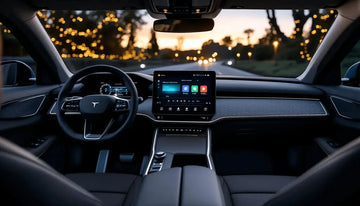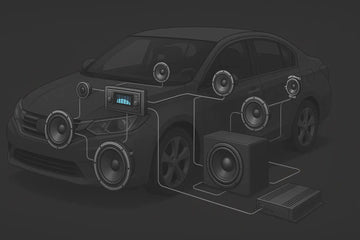Key Highlights
- car subwoofers are designed to reproduce low-frequency sounds, enhancing the bass in your car's audio system.
- They come in various types, including component and enclosed subwoofers and passive and powered models.
- Choosing your subwoofer's right size and power handling capabilities is crucial for optimal performance.
- Proper installation involves selecting a suitable location, connecting to the car's audio system, and fine-tuning for the best sound.
- Regular maintenance helps ensure the longevity and sound quality of your car subwoofer.
Introduction
A car subwoofer box can improve your music-listening experience. It gives you a special speaker just for low sounds, producing deep bass notes that let you feel the depth and richness of the sound waves from your favorite songs. Upgrading with the right subwoofer and considering its frequency range will enhance this experience. This guide will help you learn all about car subwoofers, including the importance of enclosure type. You will understand the basics, choose the right model, and install it for the best performance. Let's start changing your car audio system into a great sound experience.
Understanding Car Subwoofers: A Primer
Imagine hearing your favorite song. Instead of just the tune, you can feel the bass throughout your body. That’s what a car subwoofer can do. Regular car speakers are made for mid- and high-sounding sounds, but subwoofers are made for low sounds, called bass.
They recreate these low frequencies with great accuracy and power. Car subwoofers make your music deeper and richer, making the listening experience even more exciting, no matter what type of music you like.
Why Subwoofers are Essential for Your Car Audio System
The main benefit of adding a subwoofer to your car audio system is the deeper and more powerful bass it provides. This improved bass response is not only about being loud; it helps you enjoy the full range of sound.
Also, a subwoofer improves overall sound quality. By taking care of the low frequencies, it lets your other car speakers focus on mid- and high-range sounds. This means you will hear clearer voices, sharper instrumentals, and a more balanced sound.
A subwoofer is very important if you want to upgrade your car audio experience. It helps you enjoy music how it should be heard, with all its depth and power.
The Basics: What is a Car Subwoofer?
A car subwoofer is a special speaker for playing low sounds or bass. Normal car speakers often have trouble making these low sounds because they are smaller and do not work well with low frequencies.
This is where the subwoofer helps. It has a bigger driver and is built to deliver strong and clear bass sounds, making the audio richer and more immersive.
The subwoofer lets the other car speakers handle the midrange and treble sounds by handling the low sounds. This leads to a more balanced and pleasant listening experience for everyone.
Types of Car Subwoofers Explained

Navigating car subwoofers can be tricky at first. However, knowing the basic types can make your choices easier. Car subwoofers fall into two main categories: component and enclosed and passive and powered.
Component subwoofers give you more options for customization. On the other hand, enclosed subwoofers are easier to install. Passive subwoofers need an external amplifier to work. Meanwhile, powered subwoofers have a built-in amplifier.
Component vs. Enclosed Subwoofers
Component subwoofers are separate parts. You can pick your favorite subwoofer enclosures and adjust your sound system. This is great for people who want full control over sound pressure level and enclosure size.
Enclosed subwoofers, however, come ready to use in a matching enclosure, making setup easy. They are perfect for anyone who wants a quick solution without losing sound quality.
Whether you choose one or the other depends mostly on your available space, budget, and desired customization. Consider your choices to find the best option for your car audio setup.
Passive vs. Powered Subwoofers
When you want to power your car subwoofer, you generally have two main choices: passive or powered.
- Passive subwoofers need an external amplifier to work. They give you more control over how you want to customize your sound. They are great for those who want to have maximum flexibility.
- Powered subwoofers have a built-in amplifier. This makes the setup simpler and you won’t need a separate amplifier. They are perfect for beginners or anyone who prefers an easier installation.
Deciding between passive and powered subwoofers usually depends on a few things. These include your power handling capacity, which is measured in RMS power, your budget, and how you want to install them. Think carefully about your needs and what is most important to you to choose the best option.
Choosing the Right Size and Power
Choosing the right size car subwoofer is not just about picking the biggest one. It would be best if you considered several factors to find the best fit for your car and your audio needs. It's important to match the subwoofer's size, such as a larger subwoofer, and power handling with your car's acoustics and the current car stereo system to ensure it is the perfect match for smaller vehicles. Smaller subs may also be a viable option, depending on your space limitations, as this will help you get the best performance out of it.
Getting Started with Car Subwoofers
Installing a car subwoofer may seem difficult at first, but with some preparation, it can be easy and enjoyable. To have a successful installation, gather all the necessary tools. Also, learn about the installation steps and get your vehicle ready. This will ensure that everything goes smoothly.
Essential Equipment and Tools for Installation
Before you start the installation process, gathering all the necessary items is important. First, check your subwoofer's manual for a complete list of what you need. Generally, you will need some common equipment and tools.
These necessary items include wiring kits with the right size speaker wire, connectors to secure the wires, a wire stripper to prepare the wires, and electrical tape for insulation. If you are installing a passive subwoofer, you will also need an amplifier wiring kit designed for subwoofer installation.
Preparing Your Vehicle for Installation
Before you start the installation, it's important to get your vehicle and car audio system ready. First, disconnect the negative terminal of your car battery. This will help avoid any electrical problems during the installation.
Next, check the available space in your car. Look for the best spot for the subwoofer and any other parts, like an amplifier. You may need to remove some panels or seats to reach the wiring and places to mount the components.
Step-by-Step Guide to Installing Your Car Subwoofer
When you have all the tools you need and your car is ready, it's time to put in your car subwoofer. Although the exact steps can change based on your car model and subwoofer type, the process is quite simple.
By following these steps, you can make sure the installation is done right and safely. This will help your new subwoofer improve your car audio system to the fullest.
Step 1: Choosing the Installation Location
Choosing the right spot for your car subwoofer is very important. It helps improve sound quality and reduce any unwanted vibrations. Many car audio enthusiasts like to put the subwoofer in the trunk, often in their own enclosure. They usually face it toward the rear seats or the back of the car. This makes use of the vehicle's design to boost the bass.
Your choices may depend on the available space and the model of your car. Think about factors like how much cargo space you have and how easy it is to access. Vehicle-specific enclosures can take up less room and you can also look at other places to install it, like under the seat or in a custom box inside your car.
Keep in mind that the best subwoofer location will depend on your specific car, the size of your subwoofer, and what you like. Take the time to check your options, try out different spots, and pick the one that gives you the best sound experience.
Step 2: Wiring Your Subwoofer to the Car's Audio System
After installing the subwoofer in the right spot, the next important thing is to wire it to your car audio system. Check your subwoofer's manual and the subwoofer wiring diagrams for detailed steps. Different subwoofers and amplifiers might have different wiring setups.
Usually, you will need to connect the subwoofer's speaker wires to the matching output channels on your car stereo or external amplifier. Make sure to connect the positive (+) and negative (-) terminals correctly to prevent any damage to your gear.
Wiring it correctly helps send audio signals from your car audio system to the subwoofer. This way, the subwoofer can accurately produce the desired bass sounds, making your overall listening experience much better.
Step 3: Connecting the Subwoofer to Power
Connecting the subwoofer to power is an important step for a good audio system. If you are using a passive subwoofer, you will need to attach it to an external amplifier. The amplifier must connect to your car's battery. Make sure to pick an amplifier that matches the RMS power and peak power the subwoofer can handle. This helps you avoid overdriving it, which could damage the subwoofer.
If you have a powered subwoofer, it comes with a built-in amplifier. This makes it easier to set up. You will just need to connect the subwoofer’s power cable to the positive terminal of the battery. Don’t forget to ground it properly for safety.
No matter what type of subwoofer you use, always follow the manufacturer's instructions carefully. Also, use the right wire gauges for the connections. This way, your subwoofer will get clean and enough power to work well and safely.
Step 4: Fine-Tuning for Optimal Sound
After you install your subwoofer, it is time to set it up for the best sound quality. This means changing the settings like gain, crossover frequency, and bass boost on your car stereo or external amplifier.
Start by setting the gain to avoid distortion. This will make sure the bass adds to the music instead of overpowering it. Next, change the crossover frequency. This setting decides when your subwoofer will take over from the full-range speakers, making sure the sound blends well together.
Be careful with the bass boost feature. If you boost it too much, the sound of home can get unclear and may even harm your subwoofer. Keep in mind that great sound quality, including the loudness of each speaker, can be different for everyone, especially when using the equal volume mode or equal power mode. This provides a more direct comparison of settings, helping you make a more informed shopping decision. So, take your time and try out the settings little by little. Your goal is to get a nice and enjoyable listening experience.
Maximizing the Performance of Your Car Subwoofer

Having a car subwoofer is just the start to great sound. It's also important to know how to get the best from it.
By tuning it well and maintaining it regularly, you can ensure that your subwoofer provides strong, clear bass. This can really improve your listening experience for many years.
Adjusting Settings for the Best Sound Quality
Once you install your car subwoofer, your journey to great sound isn’t finished. The next step is to adjust your car audio settings for the best listening experience. Start by changing the equalizer settings on your car stereo. This will help you get a balanced frequency response.
Then, adjust your subwoofer's settings by focusing on the gain and crossover frequency controls. Setting the gain correctly stops distortion, ensuring the bass enhances your music instead of taking over it.
Keep in mind that perfect sound is different for everyone, especially in your own environment, as it can give you a sense of the sonic differences. It can change based on what type of music you like, your choice of amplification, and your source material. We believe that the gold standard in the real world is to try different settings. Finding what works best for you can take time, so be patient and experiment. This will help you get the most from your car audio system.
Tips for Maintaining Your Subwoofer
Like every part of your car, your car audio system and subwoofer need regular maintenance. By following some easy steps, you can help them last longer and sound better.
Check your subwoofer occasionally for loose connections or signs of damage. Wipe the cone and surround with a soft, dry cloth to remove dust and dirt that can affect sound quality. Do not use strong chemicals or rough materials, which might damage the cone.
Also, try not to play your subwoofer at full volume for long. Playing it too loud for too long can cause it to overheat and may damage its parts.
Conclusion
Understanding car subwoofers is important for improving your audio experience while driving. You can enjoy deep bass and good sound quality by picking the right size and power, installing them carefully, and taking care of them regularly. Whether you go for component or enclosed subwoofers, powered or passive, ensure they work with your car's audio system. Follow a clear installation guide and adjust the settings for the best output. This will make your driving experience more enjoyable. Don’t forget regular maintenance is vital for keeping everything running well. Explore the world of car subwoofers to enhance your audio journey!





